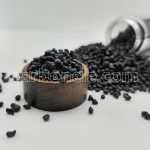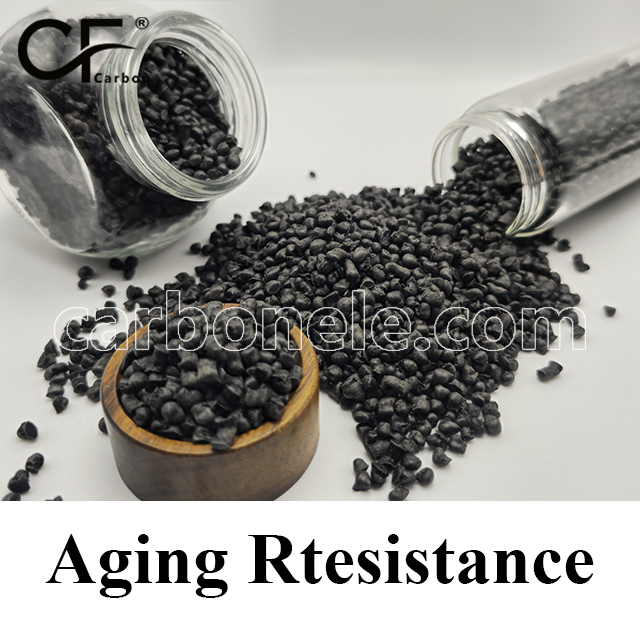
PA612 CF10 Nylon 6.12 CF10% Manufacturer Prices
PA612 CF10 blends polyamide 6.12 with 10% carbon fibers, enhancing mechanical strength, stiffness, and dimensional stability, being ideal for applications needing robust performance, heat resistance, and moderate electrical conductivity, such as automotive components and industrial parts.
- Model: PA612-CF-BCA1
- Color: Black
- Molding process: Injection/extrusion
- Free samples: 1-10kgs
- OEM/ODM: Acceptable
- Port: Xiamen port, China
What are PA6.12 CF10 thermoplastics?
PA612 CF10 thermoplastics refer to a type of material that combines polyamide 612 (PA612) with a 10% carbon fiber (CF) reinforcement. This combination offers a unique set of characteristics and advantages suitable for various industrial applications.
Why to choose this type of composites?
1. Mechanical Properties:
– Strength and Stiffness: The addition of carbon fibers significantly enhances the tensile strength and stiffness of PA612. CF10 thermoplastics exhibit improved mechanical properties compared to unreinforced PA612, making them suitable for structural applications where strength and rigidity are crucial.
– Impact Resistance: While not as impact-resistant as some unreinforced polymers, CF10 thermoplastics still offer good impact resistance due to the ductility provided by the PA612 matrix combined with the reinforcing effect of carbon fibers.
– Fatigue Resistance: Carbon fiber reinforcement can enhance the fatigue resistance of PA612 CF10 materials, making them suitable for applications subjected to cyclic loading.
2. Electrical Conductivity:
– CF10 thermoplastics may exhibit some level of electrical conductivity, depending on the type and content of carbon fibers used. While 10% carbon fiber content is relatively low for achieving high electrical conductivity, it can provide static dissipation properties.
This makes CF10 thermoplastics suitable for applications where static charge buildup needs to be controlled, such as electronic housings and automotive components.
3. Thermal Properties:
– Heat Resistance: PA612 inherently offers good heat resistance, and the addition of carbon fibers typically enhances this property. CF10 thermoplastics can withstand moderate to high temperatures without significant degradation, making them suitable for applications exposed to thermal cycling.
– Dimensional Stability: Carbon fiber reinforcement helps reduce thermal expansion, improving dimensional stability over a wide temperature range. This characteristic is beneficial in applications requiring precise dimensional control and stability.
4. Chemical Resistance:
– PA612 CF10 thermoplastics maintain good resistance to oils, greases, fuels, and many chemicals, similar to unreinforced PA612. This chemical resistance makes them suitable for applications exposed to various industrial fluids and environments.
5. Processing and Design Flexibility:
– CF10 thermoplastics are compatible with common processing methods such as injection molding and extrusion. They can be molded into complex geometries and intricate designs, offering design flexibility for manufacturers.
– The material’s processability allows for efficient manufacturing processes, contributing to cost-effectiveness and scalability in production.
6. Surface Finish and Aesthetics:
– PA612 CF10 compounds typically exhibit a smooth surface finish after molding, suitable for applications where aesthetics are important or where post-processing requirements are minimal.
7. Environmental Resistance:
– CF10 thermoplastics maintain their properties when exposed to environmental factors such as humidity and UV radiation, making them suitable for outdoor applications.
What are the applications of the materials?
PA612 CF10 thermoplastics find applications in various industries where a balance of mechanical strength, dimensional stability, and other properties is required:
– Automotive Industry: Components such as housings, brackets, and structural parts benefit from the enhanced mechanical properties and heat resistance of PA612 CF10 materials.
– Electronics: Housings for electronic devices, connectors, and static-sensitive components where static dissipation is necessary.
– Industrial Equipment: Parts requiring chemical resistance, dimensional stability, and moderate mechanical strength, such as gears, bearings, and pump components.
– Sporting Goods: Equipment that benefits from lightweight materials with good strength and impact resistance, such as bicycle components and sports equipment.
– Consumer Goods: Applications requiring durable materials with aesthetic appeal, such as handles, housings for appliances, and outdoor equipment.
– Aerospace and Defense: Non-critical structural components, housings, and brackets where weight reduction and mechanical performance are essential.
PA612 CF10 thermoplastics offer a balanced combination of mechanical strength, stiffness, heat resistance, dimensional stability, and chemical resistance due to the incorporation of carbon fibers into the PA612 matrix.
These properties make CF10 thermoplastics suitable for a wide range of applications across industries, from automotive to electronics, where performance under demanding conditions is required.
By leveraging these characteristics, manufacturers can achieve innovative designs and meet the stringent requirements of modern applications effectively.
Content Block 1
Morbi iaculis at quam vel faucibus. Ut semper ipsum ex, quis aliquet justo pretium a. Suspendisse scelerisque metus augue, a interdum leo iaculis sed. Vivamus sit amet nunc odio. Duis vel pulvinar dolor, at lacinia tellus.
Pellentesque habitant morbi tristique senectus et netus et malesuada fames ac turpis egestas. Suspendisse lacinia quam a elit lobortis tempor


Content Block 1
Morbi iaculis at quam vel faucibus. Ut semper ipsum ex, quis aliquet justo pretium a. Suspendisse scelerisque metus augue, a interdum leo iaculis sed. Vivamus sit amet nunc odio. Duis vel pulvinar dolor, at lacinia tellus.
Pellentesque habitant morbi tristique senectus et netus et malesuada fames ac turpis egestas. Suspendisse lacinia quam a elit lobortis tempor

Frequently Asked Questions
Carbon (Xiamen) New Material Co., Ltd. aims to provide buyers with "one-stop" worry-free high-quality services. Here you can find all information about carbon fiber engineering plastics. If you still have questions, please send us an email for consultation!
-
How can I contact the manufacturer of a product that interests me?
When you find a product you are interested in, you can contact the manufacturer directly by sending an email and we will get back to you as soon as possible.
-
How do I find the products that interest me?
All you need to do is enter the keyword, product name in the search window and press the Enter key on your keyboard. Your search results page will then be displayed. You can also search within the product category pages on the home page. Each category is divided into subcategories, allowing you to refine your search and find products that interest you.
-
Where will I find a buying guide?
Please contact our after-sales service directly and we will provide you with a comprehensive operating guide.
-
What are CF Reinforced Thermoplastic Composites?
CF Reinforced Thermoplastic Composites are materials where carbon fibers are incorporated into a thermoplastic matrix. They combine the strength and stiffness of carbon fibers with the processability and recyclability of thermoplastics. For instance, they are used in automotive parts like bumper beams.
-
What are the benefits of CF Reinforced Thermoplastic Composites over traditional composites?
The key benefits include faster production cycles, easier recyclability, and better impact resistance. They also offer design flexibility. An example is in the manufacturing of consumer electronics casings where complex shapes can be achieved more easily.
-
How are CF Reinforced Thermoplastic Composites processed?
Common processing methods include injection molding, extrusion, and compression molding. Injection molding is widely used for mass production. For example, in the production of small components for the medical industry.
-
What industries use CF Reinforced Thermoplastic Composites?
They are utilized in aerospace, automotive, medical, and sports equipment industries. In aerospace, they can be found in interior components. In the medical field, they might be used in prosthetics.
-
How does the carbon fiber content affect the properties of the composites?
Higher carbon fiber content generally leads to increased strength and stiffness but may reduce ductility. A moderate content is often balanced for specific applications. For example, a higher content might be preferred in structural parts of a race car.
-
What are the challenges in using CF Reinforced Thermoplastic Composites?
Challenges include higher material costs, complex processing equipment requirements, and ensuring uniform fiber dispersion. Issues with adhesion between the fibers and the matrix can also arise. An example is in achieving consistent quality in large-scale production.























